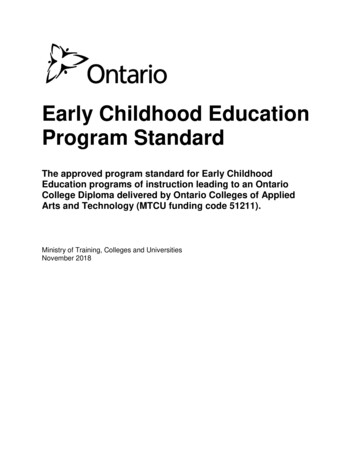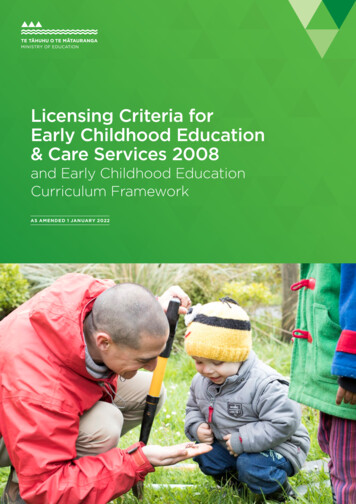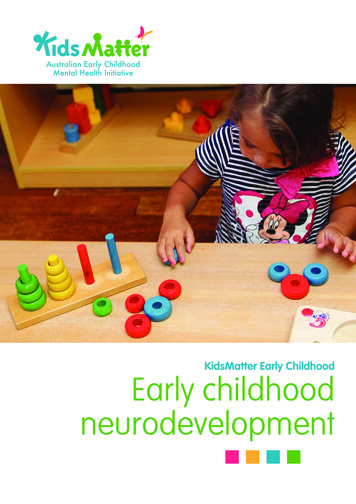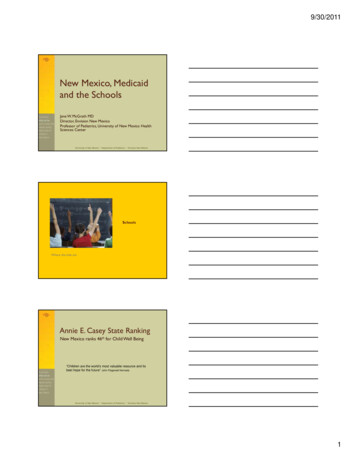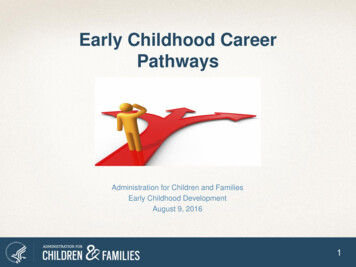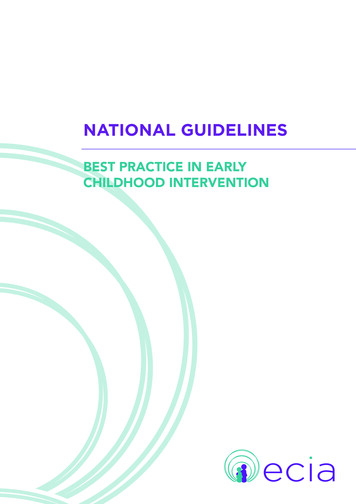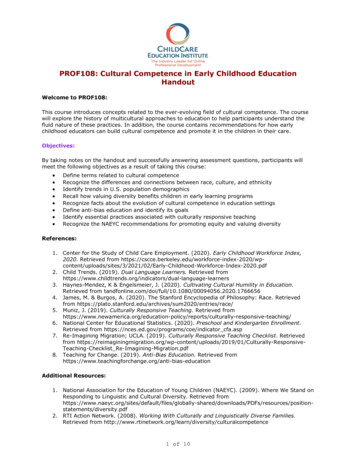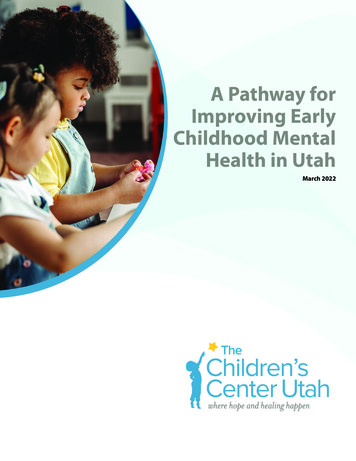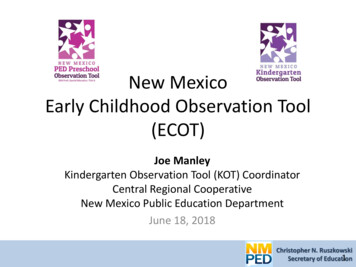
Transcription
New MexicoEarly Childhood Observation Tool(ECOT)Joe ManleyKindergarten Observation Tool (KOT) CoordinatorCentral Regional CooperativeNew Mexico Public Education DepartmentJune 18, 2018Christopher N. Ruszkowski1Secretary of Education
Purpose of the Tools Preschool Observation Tool – gather information on whatchildren know and can do at the time of preschool entry anddocument growth over the preschool year(s) Kindergarten Observation Tool – gather information on whatchildren know and can do at the time of kindergarten entry Assist teachers in data-driven instructional decision makingat the child and classroom level Identify individual children’s needs and provide necessarysupports to children and teachers Provide families with information about their children’slearning and development Inform education and care stakeholdersChristopher N. Ruszkowski2Secretary of Education
Christopher N. Ruszkowski3Secretary of Education
Christopher N. Ruszkowski4Secretary of Education
Sample Indicator RubricChristopher N. Ruszkowski5Secretary of Education
Christopher N. Ruszkowski6Secretary of Education
Uses of ECOT All New Mexico Public Education DepartmentPreK programs (serving 3Y SPED, and 4Ychildren) All kindergarten classrooms across the statesince 2016Christopher N. Ruszkowski7Secretary of Education
ECOT - Reporting Immediate Reporting Cascading levels of access Reports:– Student Summary (and Growth)– Portfolios (PreK)– Family/Teacher Report– Classroom/School/District/State Summary ReportsChristopher N. Ruszkowski8Secretary of Education
Christopher N. Ruszkowski9Secretary of Education
Christopher N. Ruszkowski10Secretary of Education
DevelopmentChristopher N. Ruszkowski11Secretary of Education
2017 Validation Study – REL SouthwestDahlke, K., Yang, R., Martínez, C., Chavez, S., Martin, A., Hawkinson, L., Shields, J., Garland, M., & Carle, J. (2017). Scientific evidence for the validity of theNew Mexico Kindergarten Observation Tool (REL 2018–281). Washington, DC: U.S. Department of Education, Institute of Education Sciences, NationalCenter for Education Evaluation and Regional Assistance, Regional Educational Laboratory Southwest. Retrieved from https://ies.ed.gov/ncee/edlabs/.Christopher N. Ruszkowski12Secretary of Education
https://www.youtube.com/watch?v k1ei-G m2DI&feature thwest/pdf/REL 2018281.pdfChristopher N. Ruszkowski13Secretary of Education
Validated Domain Structures PreK– General school readiness– Two-factor structure Academic Knowledge and Skills Learning and Social Skills Kindergarten– General school readiness– Two-factor structure Academic Knowledge and Skills Learning and Social Skills– Four-factor structure Physical and Motor Skills Literacy Mathematics Learning and Social SkillsChristopher N. Ruszkowski14Secretary of Education
Training and SupportDevelopment of online learning modules (no costto the LEAs): Returning Teacher ModuleNew Teacher PreK ModuleNew Teacher K ModuleOngoing TA and support from Public EducationDepartmentChristopher N. Ruszkowski15Secretary of Education
Continuous Improvement Teacher and additional user feedbackItem refinementFour-step data analysis trainingECOT system improvementChristopher N. Ruszkowski16Secretary of Education
Successes Alignment of PreK and K data in a single systemAlignment of “K ready” expectationsData to support individual needs of childrenParent/Teacher Reports and conferencesNavigating current assessment climate successfullyChristopher N. Ruszkowski17Secretary of Education
Advice Understand the needs of your communities.Communicate early, openly, and honestly.Build communities of support.Respond to the needs of the users.Christopher N. Ruszkowski18Secretary of Education
The Pennsylvania Kindergarten Entry InventoryThe PennsylvaniaKindergarten Entry InventoryMary Anne OlleyEarly Educator Advisor IICommonwealth of PennsylvaniaJune 18, 2018
The Pennsylvania Kindergarten Entry InventoryPurpose of the PennsylvaniaKindergarten Entry InventoryPublic schools in Pennsylvania do not have a standard tool to assess the status ofchildren at kindergarten entry across a broad range of domains.Pennsylvania teachers, school administrators, and state policy makers are inneed of an inventory of student skills and competencies that: addresses a broad range of cognitive and non-cognitive domains, is aligned to the Pennsylvania Early Learning Standards and PennsylvaniaAcademic Standards, and can be easily completed by teachers at the beginning of the school year.The Pennsylvania Kindergarten EntryInventory is intended to be used bykindergarten teachers to record students’demonstration of skills within the first 45calendar days of the kindergarten year.
The Pennsylvania Kindergarten Entry InventoryWhy did Pennsylvaniachoose to develop its own tool?
The Pennsylvania Kindergarten Entry InventoryThe PennsylvaniaKindergarten Entry Inventory Deny or exclude access to kindergartenfor those children who are age eligibleNot intended to Determine placement in a program,class, or special education Replace an assessment or evaluationof a child Serve as high-stakes assessment ofprograms, teachers, or children
The Pennsylvania Kindergarten Entry InventoryTime and Resources
The Pennsylvania Kindergarten Entry InventoryDedicated web page toPennsylvania’s Kindergarten Entry Inventoryhttp://kei-pa.orgPennsylvania’s Office of Child Developmentand Early Learning Researchhttp://www.ocdelresearch.org/default.aspx
The Pennsylvania Kindergarten Entry InventoryDoing it RIGHT!Pennsylvania Kindergarten EntryInventory Validation Study ResultsWhat was learned?
The Pennsylvania Kindergarten Entry InventoryEvidence-based Uses of the Kindergarten Entry InventoryUse of the Emerging Academic Competencies and LearningEngagement Competencies dimensions of the PA KEI:1. Teachers use scores to inform instruction for all children at kindergarten entry.2. Teachers use ratings on the individual PA KEI indicators to inform instructionfor all children at kindergarten entry.3. Policymakers, school district leaders, and principals use average scores atthe state, district, or school level across all children rated on the PA KEI toprovide a descriptive snapshot of children’s competencies.*No scientific evidence was found for making comparisons among districts or among schools within districts.
The Pennsylvania Kindergarten Entry InventorySustainabilityIt’s not JUST about the tool!27
The Pennsylvania Kindergarten Entry InventoryFor more information on thePennsylvania Kindergarten Entry InventoryPlease contactRA-PWOCDKEI@pa.govThe mission of the department is to academically prepare children and adults to succeed asproductive citizens. The department seeks to ensure that the technical support, resources andopportunities are in place for all students, whether children or adults, to receive a high qualityeducation.
TOM TORLAKSONState Superintendentof Public InstructionDesired Results Developmental Profile—KindergartenDRDP-K (2015)A Developmental Continuum for KindergartenSerene YeeEducation Program ConsultantEarly Education and Support DivisionCalifornia Department of EducationKerry Kriener-AlthenWestEd Center for Child & Family StudiesJune 18, 201829
Desired Results DevelopmentalProfile—Kindergarten (DRDP-K) (2015)TOM TORLAKSONState Superintendentof Public Instruction DRDP-K (2015)– Developed for California– Extended the DRDP (2015)—A developmental continuumfrom early infancy to kindergarten entry– Provides information about learning and development in upto 11 domains Who uses the DRDP-K?– Menu option: Available but not required for all kindergartenand transitional kindergarten programs in California– Adopted as statewide KEA: available but not required inIllinois (currently 97% of districts have adopted)– Adopted as statewide KEA: Available and mandatory forpiloting districts in Tennessee; graduated roll out statewide30– Menu option: Colorado and Louisiana
Development and Adoption HistoryTOM TORLAKSONState Superintendentof Public Instruction31
Data Use From DRDP-KTOM TORLAKSONState Superintendentof Public Instruction Teachers enter DRDP-K data into DRDPtech by the endof pre-determined rating periods– For use as a KEA, DRDP-K is completed within about6–8 weeks of kindergarten entry DRDPtech :– Stores data in a secure statewide database– Automatically generates psychometrically valid assessmentreports, for individual children and for groups of children forinstructional and reporting purposes– Group reports are available at district, classroom, or sub-group levels(state-level reports coming later this year)– Group reports can specify sub-groups (e.g., dual-language learners,children with IEPs) to support group instruction and curriculum planning– Child reports can be used in parent-teacher conferences to reflect onchild’s development and progress– Parent report can be used as a report card with information for parentsabout their child’s development and activities to support learning at home32
Rationale for Selecting the DRDP-K(2015)TOM TORLAKSONState Superintendentof Public Instruction Stakeholders requested an assessment for kindergartenentry Early Education and Support Division (EESD) of theCalifornia Department of Education (CDE) decided toextend existing DRDP infant/toddler and preschoolcontinuum to ensure a formative, comprehensivecontinuous, standards-aligned, reliable and validassessment instrument for kindergarten33
Rationale for Selecting the DRDP-K(2015)TOM TORLAKSONState Superintendentof Public Instruction EESD continued their 15 year partnership with WestEdand University of California, Berkeley Evaluation andAssessment Research Center (UC BEAR Center) todevelop the DRDP-K (2015)– Measures drafted by nationally recognized childdevelopment research experts– Measures reviewed in a rigorous iterative process by EESD,DRDP project staff, and stakeholders from higher education,special education, and culture and language diversitycommunities– Piloted and tested for reliability and validity– Multidimensional Item Response Theory Model providespsychometrically valid domain scale scores that incorporateall measures of a domain, allowing each measure to vary incomplexity and difficulty, and allows for comparisons across34developmental domains
Educator Training and PreparationTOM TORLAKSONState Superintendentof Public Instruction In California, training and professional development areavailable:– State-sponsored online modules are free to teachers– State-sponsored online rater certification is free to teachers– State-sponsored and for fee in-person trainings for teachersand administrators– For fee Certified Trainer Institute (CTI)Organizations or districts may pay to certify an onsite trainer toprovide ongoing coaching and training for teachers In Illinois and Tennessee, training for teachers andadministrators is provided by the state, along with accessto a statewide database– For fee onsite technical assistance can be provided tosupport districts to integrate the DRDP-K with their existingassessment and curriculum activities– Customized online training modules and tutorials can bedeveloped upon request35
Administration of the DRDP-K (2015)TOM TORLAKSONState Superintendentof Public InstructionTeachers complete individual ratings for each child:36
Group ReportTOM TORLAKSONState Superintendentof Public InstructionParent Report37
Communication With StakeholdersTOM TORLAKSONState Superintendentof Public InstructionCommunication Process In California:– DRDP-K web site– Presentations at statewide conferences and districts– Presentations to districts using the 0–5 instrument– Letter from State Superintendent In Illinois:– Superintendent’s Monthly Newsletter– Presentations at statewide meetings and conferences– Regional presentations– Regional coaches trained to provide onsite support andtraining38
Issues and Concerns DRDP-K can be time consuming for teachers to completeTOM TORLAKSONState Superintendentof Public Instruction– Becomes less time consuming as teachers learn how to integratedocumentation into their instructional practiceView Options# of Domains# of MeasuresComprehensive11 domains55 measuresSelect specificdomainsExample:5 school readiness domainsExample:29 measuresEssentialSelected measures from 5school readiness domains25 measuresSnapshot(Aggregate only)Selected measures from 4domains17 measures DRDPtech needs to be more user-friendly and efficient– Working on a new user interface– Linking ratings from portfolio App with DRDPtech39
CostsTOM TORLAKSONState Superintendentof Public Instruction The DRDP-K instrument is available online, for free downloadat www.drdpk.org To enter data into DRDPtech and have access to DRDPtechreports, there is a per-child feeAgencyNumber of ChildrenCost per YearOther CA agencies 200 300 200 300 plus 2.00 per additionalchild over 200N/A 50 flat feeFamily Child CareHomes in CAOther agencies outsideCAPlease contact WestEd Training fees depend on the level of training desired40
Advice for Other States Challenges with Menu OptionsTOM TORLAKSONState Superintendentof Public Instruction– Difficult to conduct aggregate statewide data analysis whendifferent instruments have been used to collect data– Difficult to track individual children’s progress if they move toa different school or district that uses a different assessment– Teachers may need new training when they move to a newdistrict or school that used a different assessment Flexibility Built Into the Assessment– Different views of the instrument are available with varyingnumbers of domains or measures to tailor to each state’sneeds– The Multidimensional IRT psychometric model thatunderlies DRDP-K enables accurate quantitative domainratings from qualitative measure rating– Tracking developmental progress for individual children andfor groups of children (classroom, district, state)41
Number of Children. Cost per Year . Other CA agencies 200: 300 200: 300 plus 2.00 per additional child over 200 . Family Child Care Homes in CA: N/A. 50 flat fee : Other agencies outside CA. Please contact WestEd Training fees depend on the level of training desired 40
